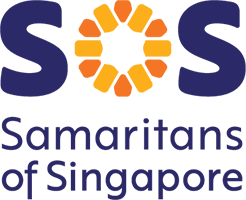SOS Launches New Logo, Pursues New Service Platform for Those in Distress
Event: Launch of the new SOS brand logo
Date: 6 February 2018, Tuesday
Time: 9am – 12pm
Venue: Lifelong Learning Institute, Event Hall 1-1
GOH: President of the Republic of Singapore, Mdm Halimah Yacob
SOS Patron: Minister for National Development and Second Minister for Finance, Mr Lawrence Wong
Special Guest: Adjunct Professor, Lee Kuan Yew School of Public Policy, National University of Singapore and SOS Former Patron, Mr Mah Bow Tan
Samaritans of Singapore (SOS) officially launched its new brand logo on 6 February 2018, Tuesday. The closed door event took place at the Lifelong Learning Institute, with attendance by invitation only.
The change represents a brand refresh for the organisation, which serves as Singapore’s only crisis intervention and suicide prevention centre.
“While the work at SOS revolves around the sombre topic of suicide, the emphasis in our message revolves around the positive aspects of help-seeking, resiliency, and having the community come together to play their part in suicide prevention. For this, we need to present ourselves as not just approachable, but embracing changes in society as well – and increasingly so, in appealing to all audiences.” Executive Director of SOS, Ms Christine Wong, mentioned.
The re-imagined logo, created by APT 811 design and innovation agency, consists of the abbreviation SOS and the words Samaritans of Singapore; with the letter O in the abbreviation stylized as a graphical representation of a flower.
This is the second time SOS has changed its brand logo since its inception in 1969. The logo being replaced has been in use since 2006.
Accompanying the change of logo, SOS has also reworked its corporate website to reflect the change in brand image. The new website will contain updated content and a blog section, where SOS will publish shareable articles on a regular basis.
The blog feature is part of SOS’s continual outreach efforts in building an accurate perception of suicide and increasing the awareness of suicide prevention in Singapore.
Taking their community education efforts one step further, SOS is also planning to roll out additional training programmes to the community. Part of a suicide prevention strategy is only effective when more people are trained to watch out for those facing a crisis, or those who may not be able to cope with the difficulties they are facing.
Just this year, SOS’s three current mainstay training programmes on suicide prevention and intervention skills were approved under the SkillsFuture credit scheme.
Minister Lawrence Wong, Patron of SOS, said: “Suicides are tragic events which can severely affect families and communities. Suicide prevention involves our collective efforts. Volunteer organisations such as the SOS play a critical role in raising awareness on suicides and the available avenues for help. Lives have been saved because of the good work of SOS and its volunteers – their public education efforts, 24-hour crisis intervention and suicide prevention hotline. Through this rebranding exercise, I hope that the SOS will be able to enhance its outreach, and remain relevant and accessible to those who need help.”
During the event, SOS also set itself a target to launch a pilot text messaging service by the end of this year. This new service will act as a help-seeking resource for individuals, especially youth, who are facing distress and who may not know what help they can turn to.
Internationally, some organisations which already provide such a service include youthspace.ca (Canada), Lifeline Australia, and Crisis Text Line (USA). Not surprisingly, most of these organisations’ texts messaging services are aimed at youth below the age of 30.
Operationally, SOS hopes to emulate the model set by the Crisis Text Line founded by Nancy Lublin in the USA.
The movement to form helplines as a means of providing emotional support to the distraught emerged in the late 1950s to 1960s in America and the UK. It was also around this time that the idea spread to Singapore, with SOS beginning operations in 1969. Since then however, communication methods have evolved.
In 2013, Lublin, CEO at teenage outreach organisation Dosomething.org, sensed the shift in tech habits and started providing crisis counselling via text messaging. Currently, three-quarters of Crisis Text Line’s users are under 25 years old.
SOS currently runs a 24-hour crisis hotline which received over 35,832 calls in 2016. Of those who disclosed their age, only 5,241 or 19.1% of calls were from those below the age of 30. Comparatively, SOS’s email befriending service saw 71% of incoming emails from the same age group.
SOS believes that newer technologies, such as text message service, will better appeal to youth who are digitally savvy and those who are mobile natives.
In the South-East Asia edition of the Deloitte 2017 Global Mobile Consumer Survey, it was found that the most popular class of mobile applications used by Singaporeans aged 16-44 was messaging. This is in contrast to social networking applications in Indonesia, Malaysia, and the Philippines; and gaming applications in Thailand.
Youth suicides have been in the spotlight due to high profile cases of teen suicides in recent years, and when the number of teen suicides hit a fifteen-year high of 27 in 2015.




